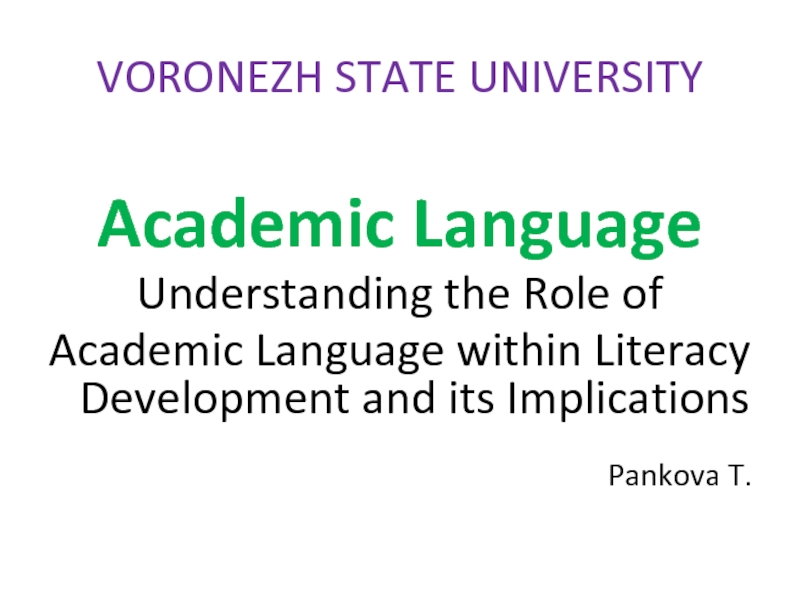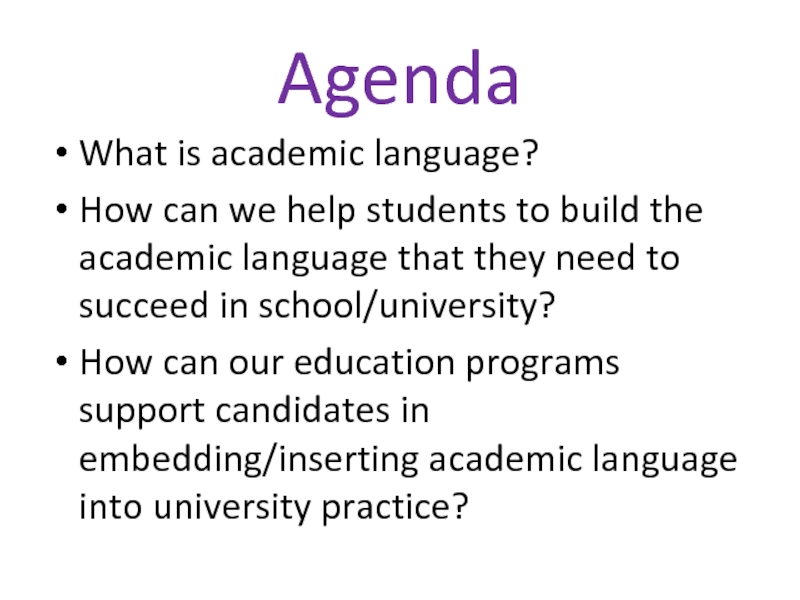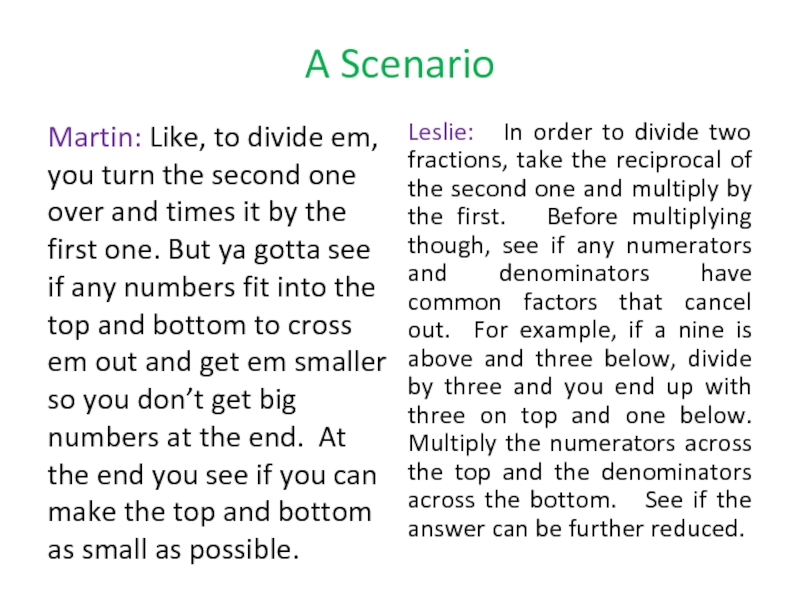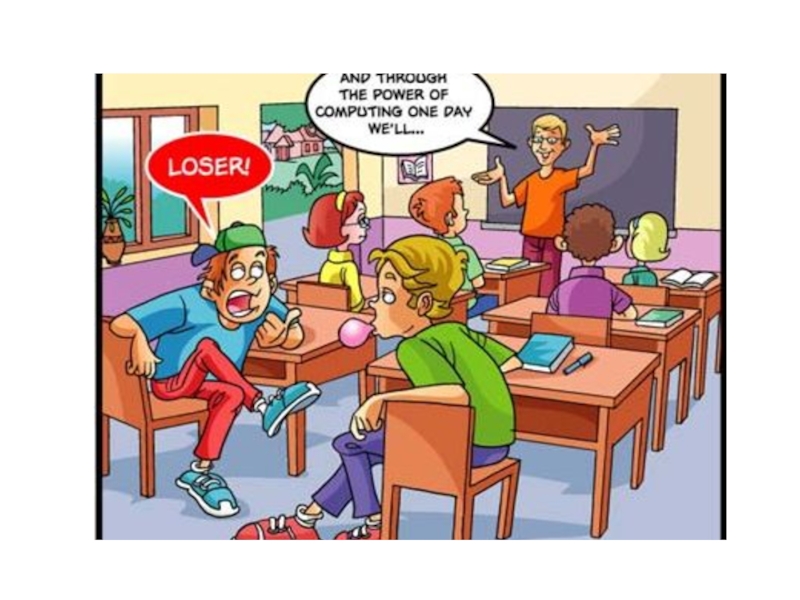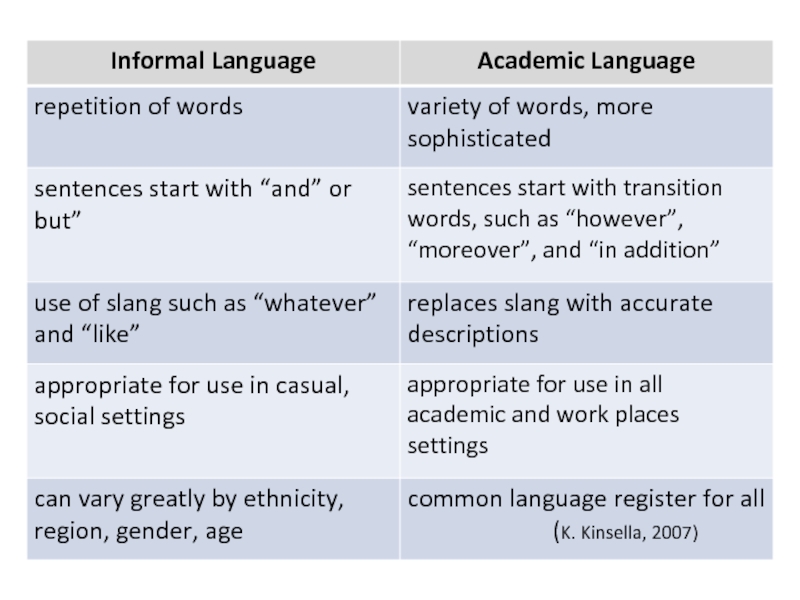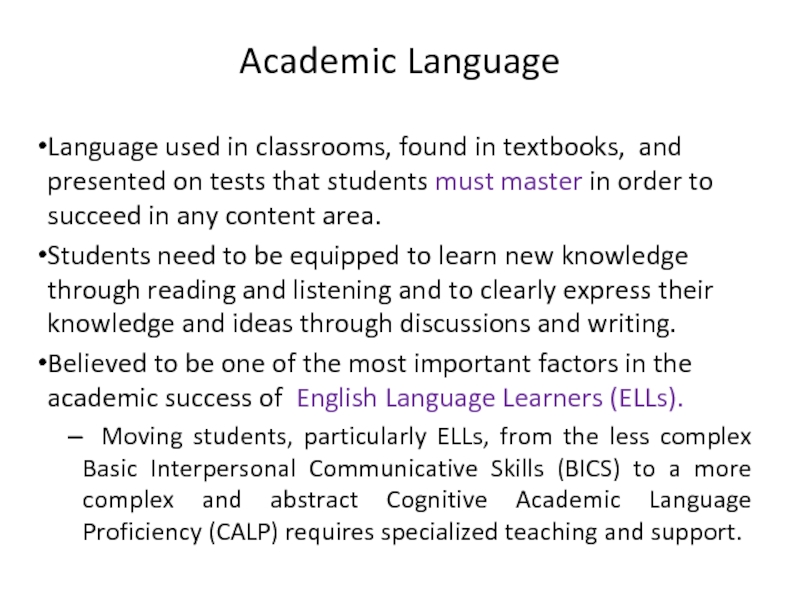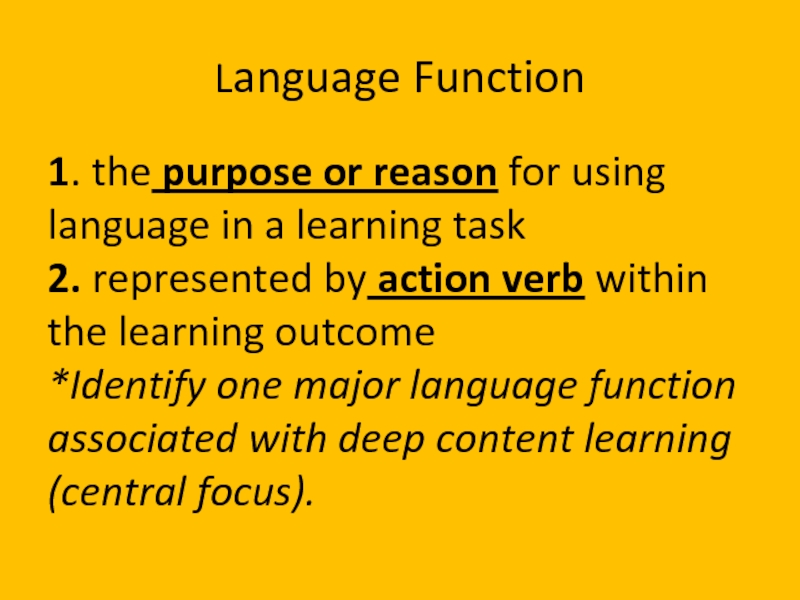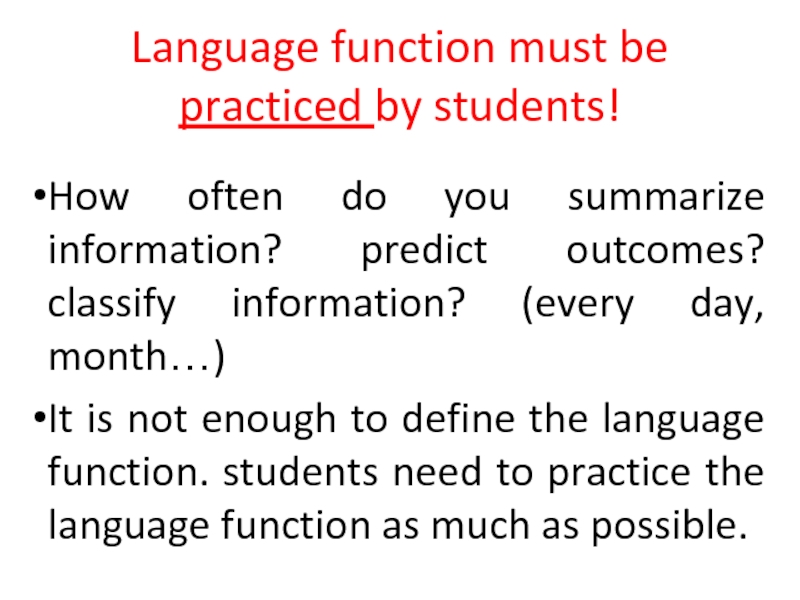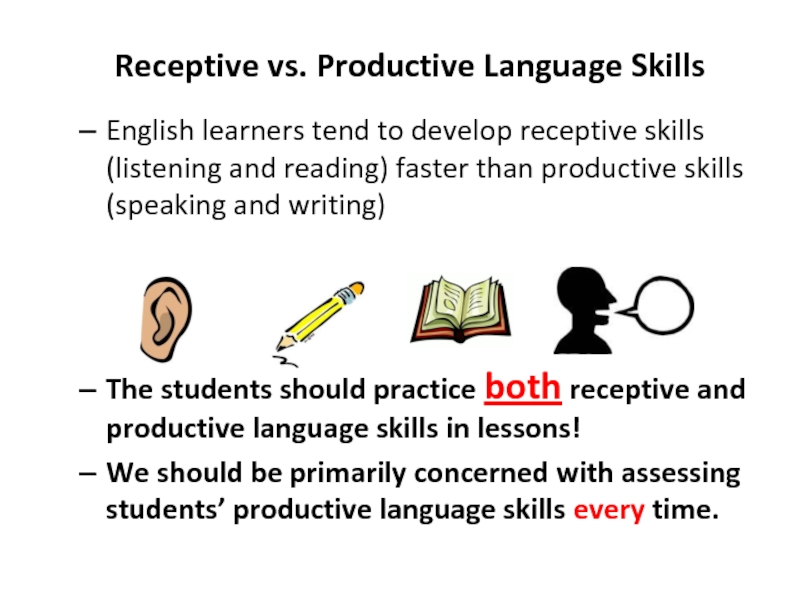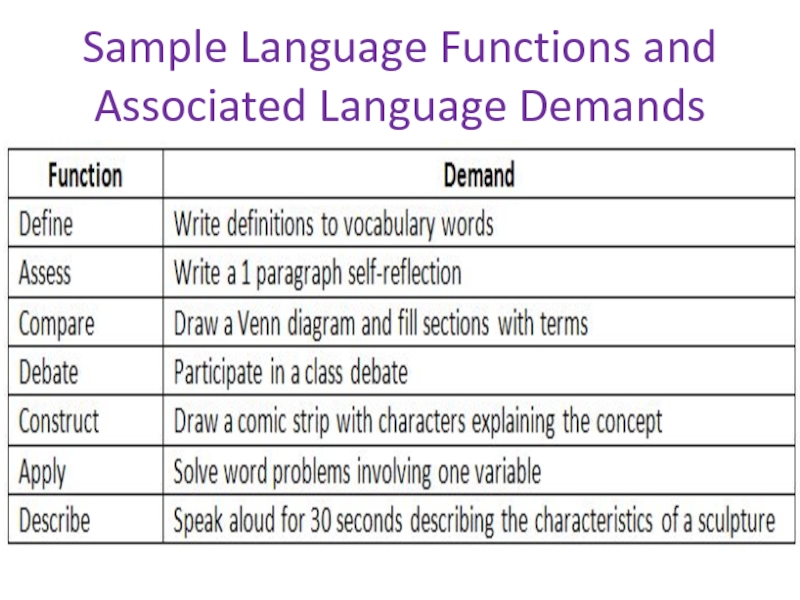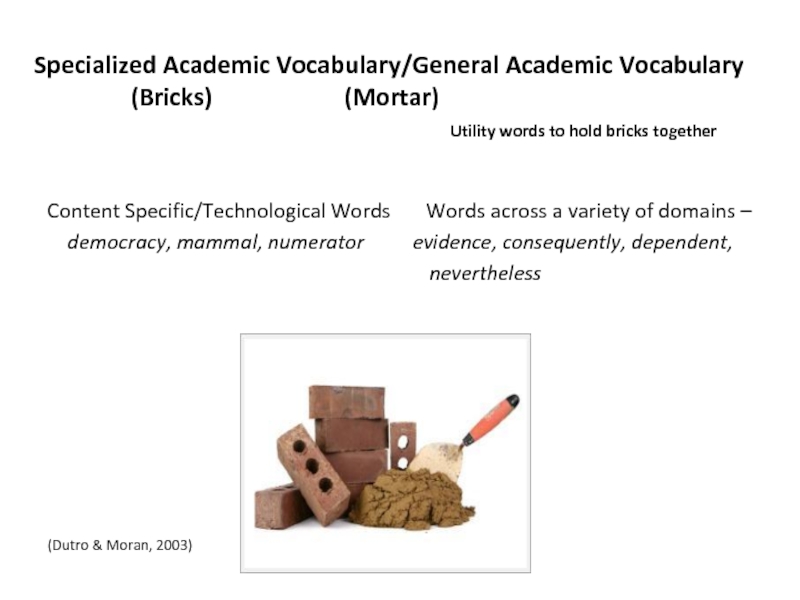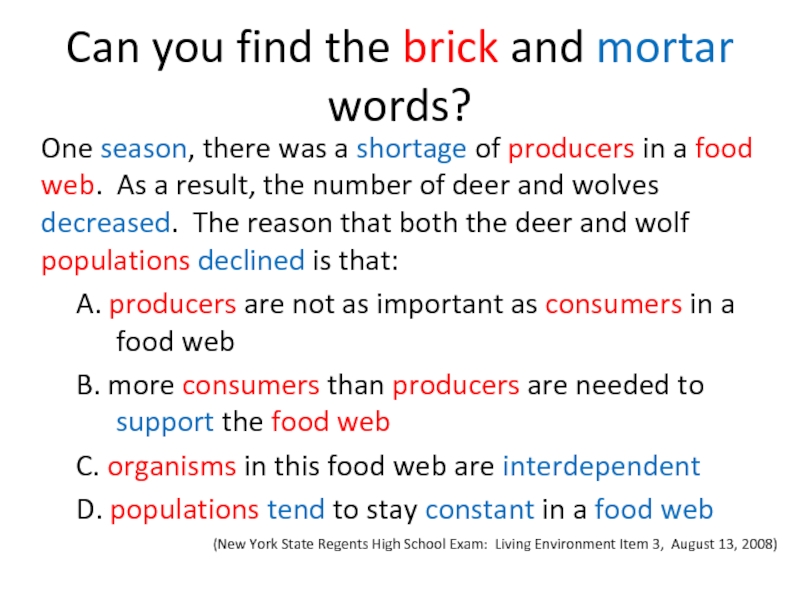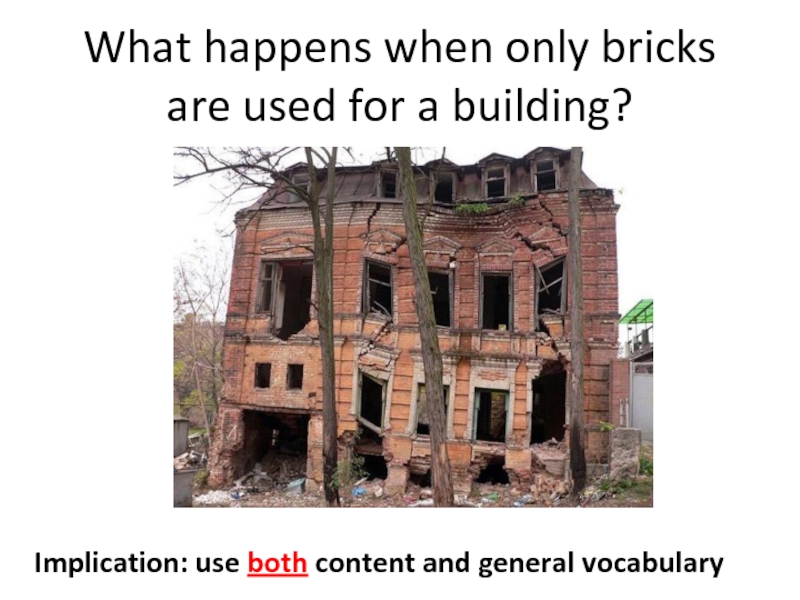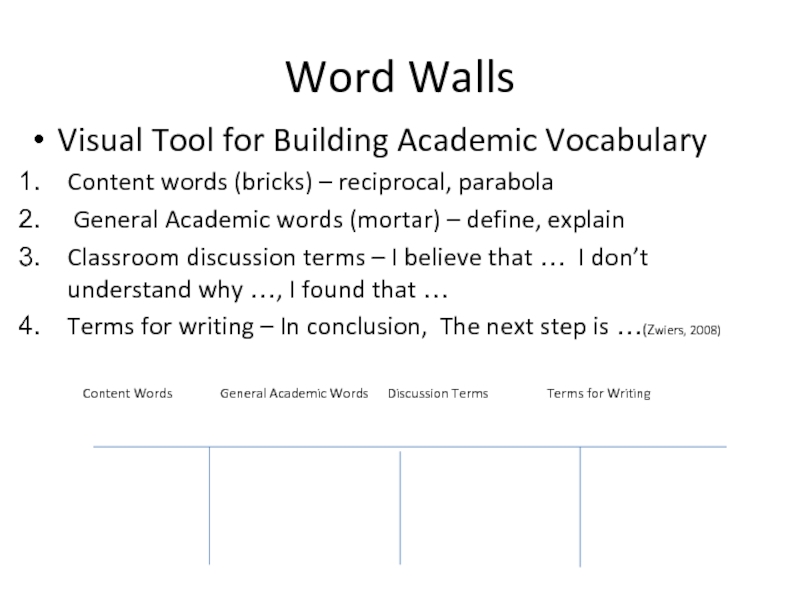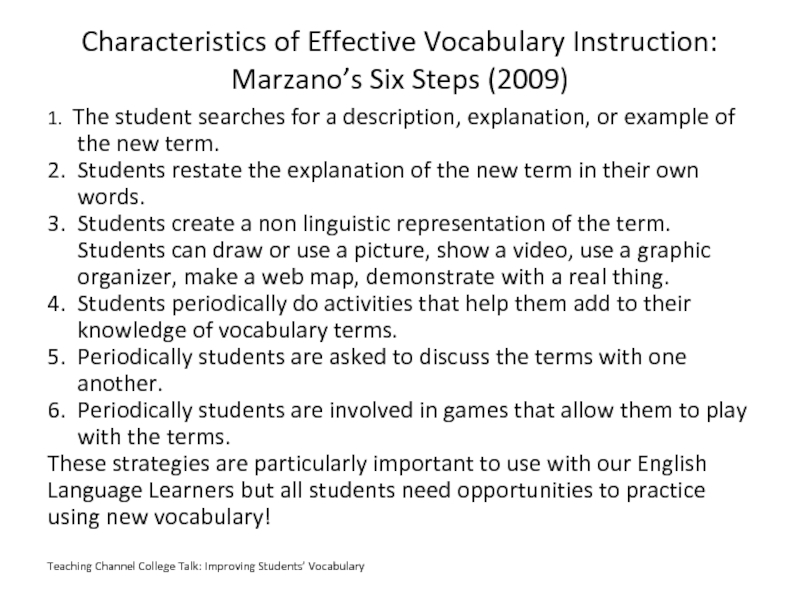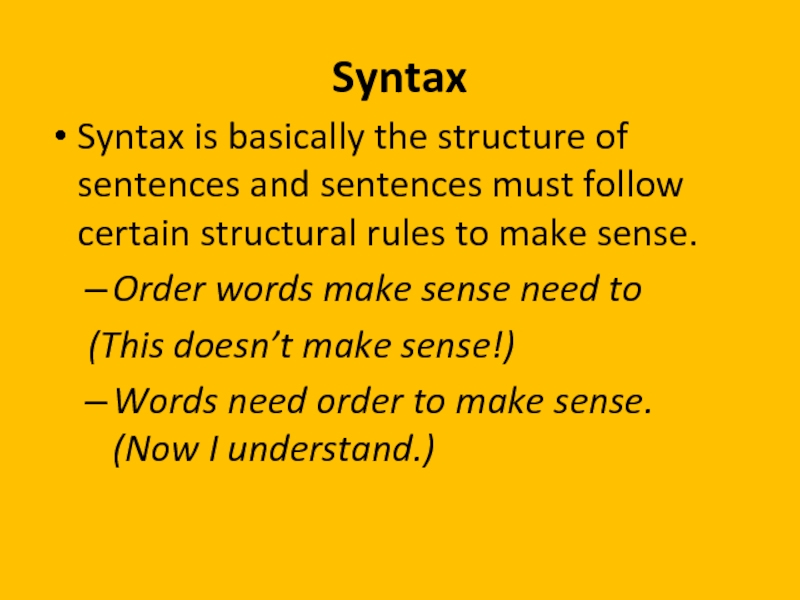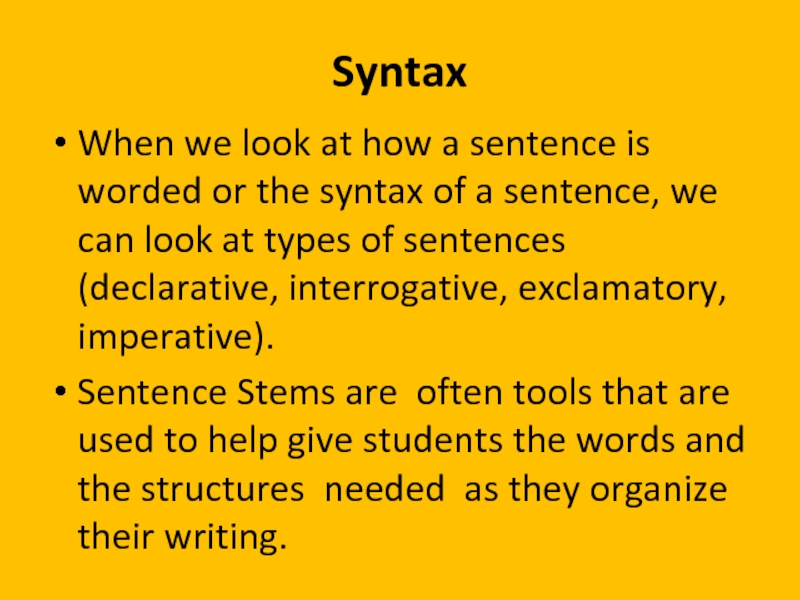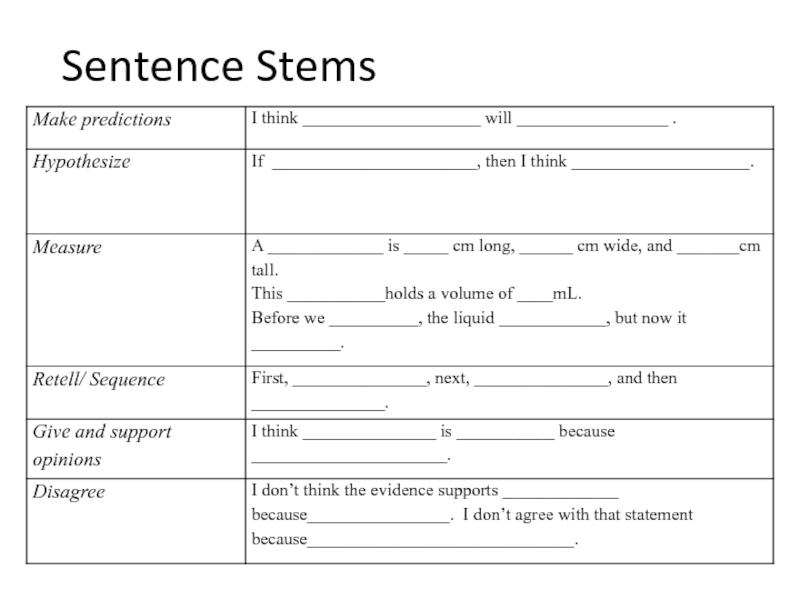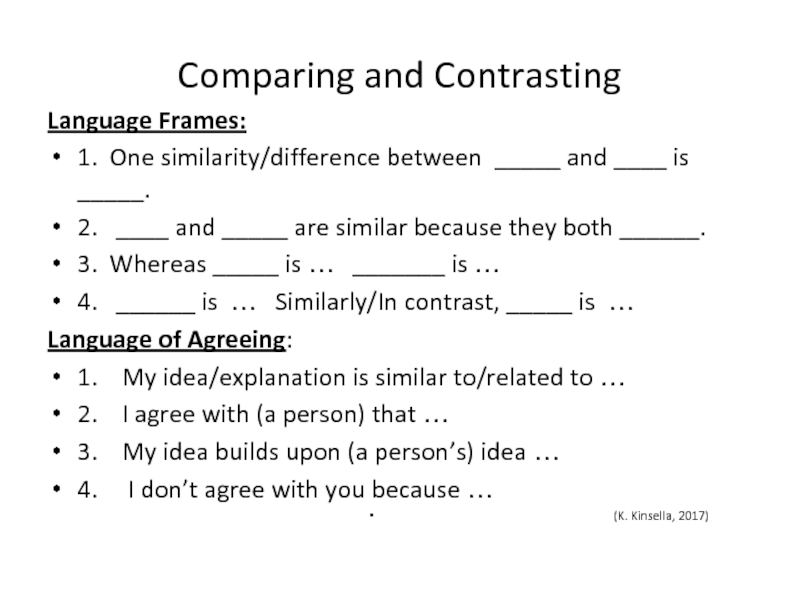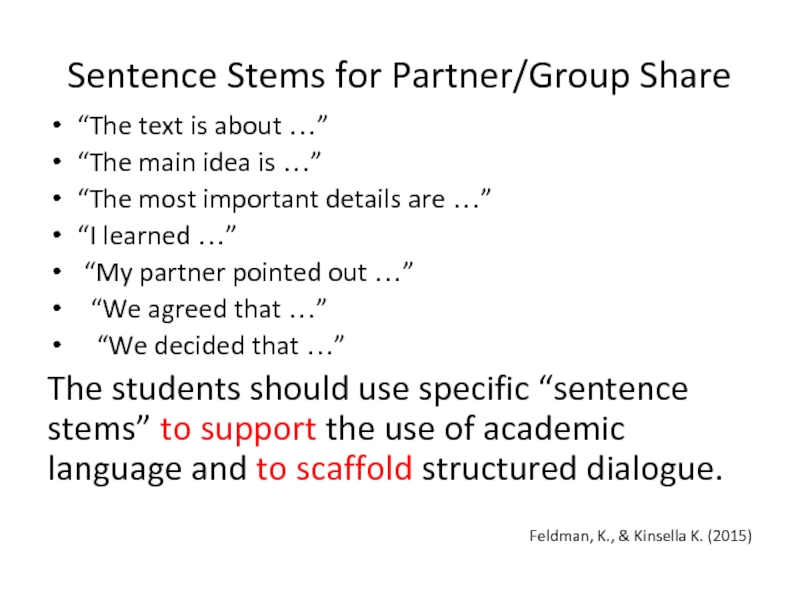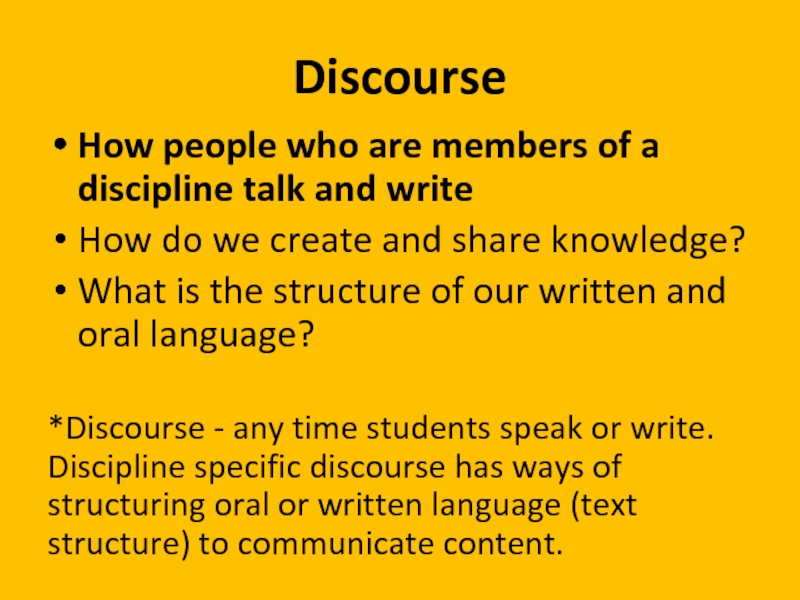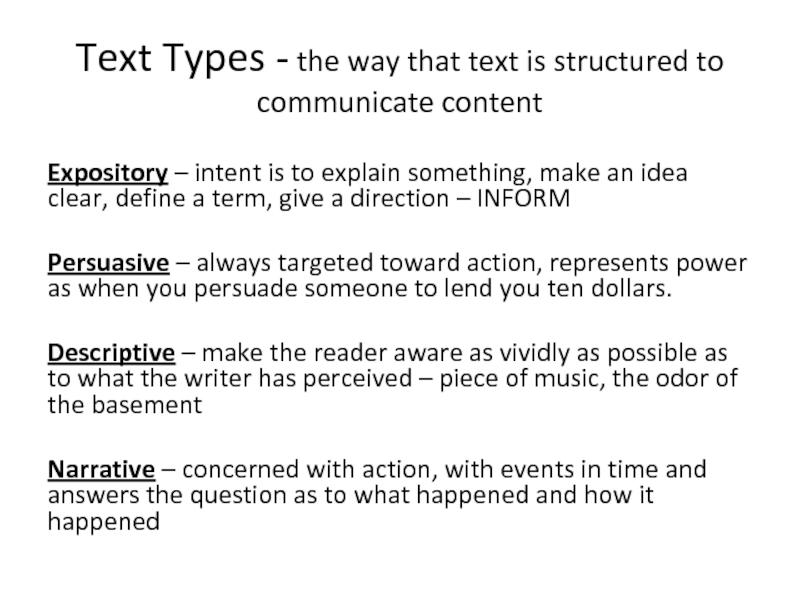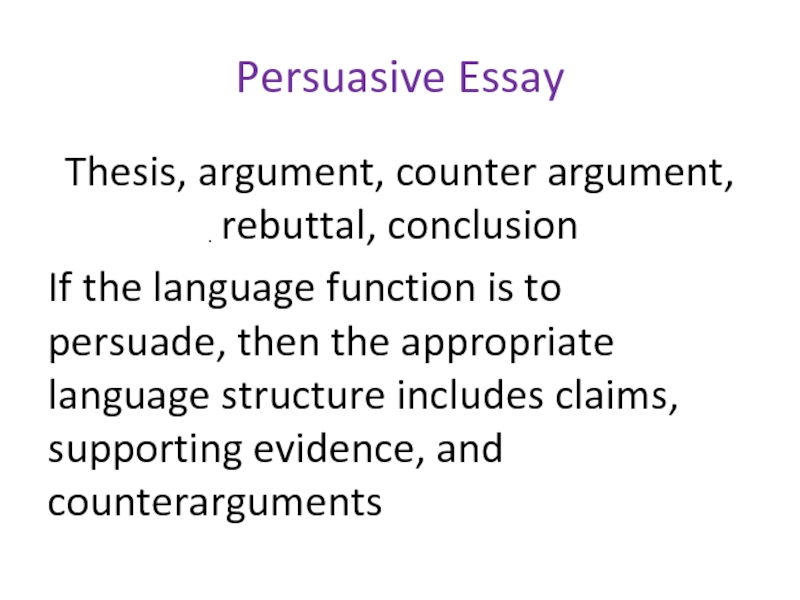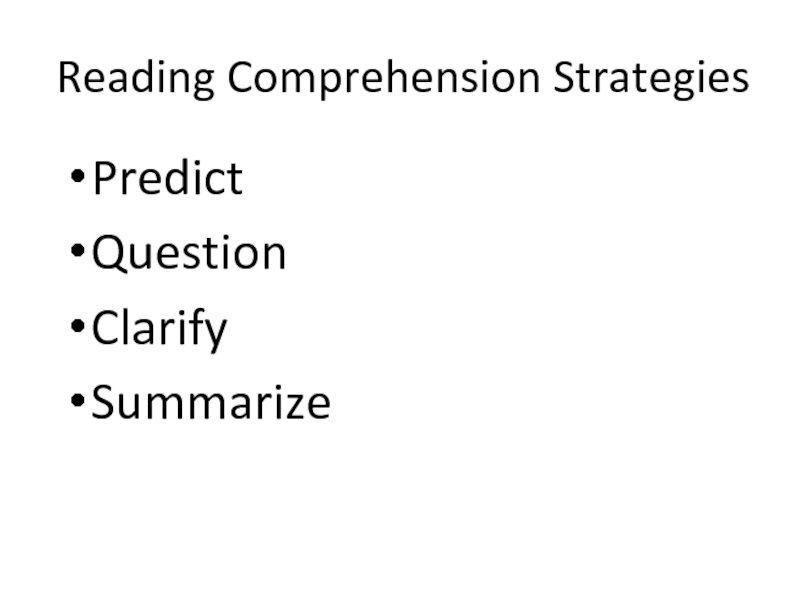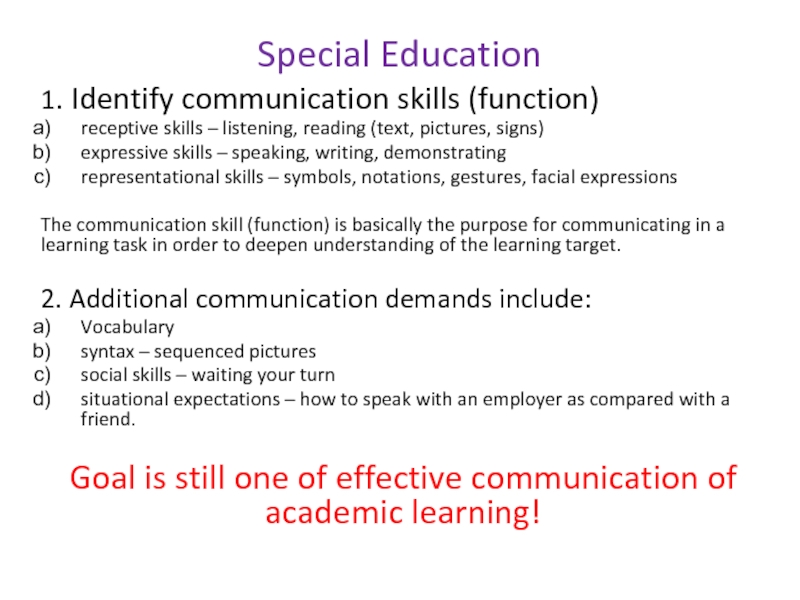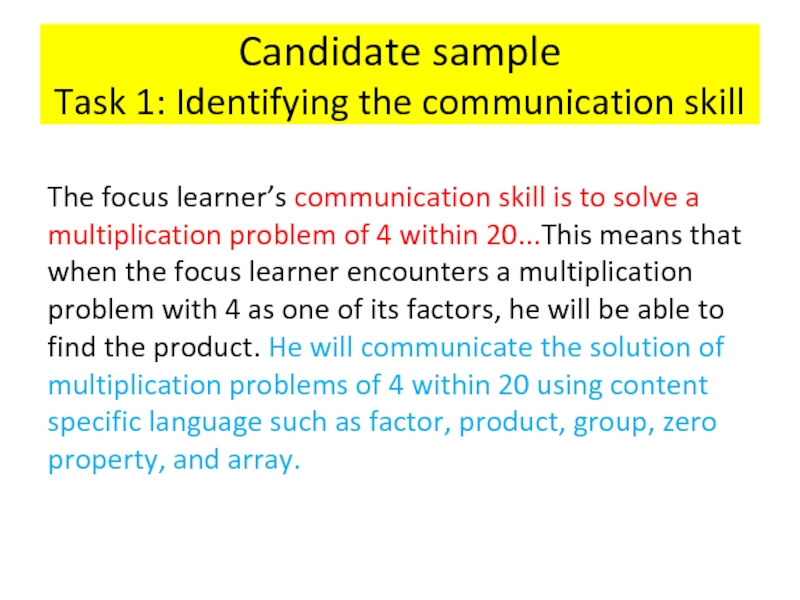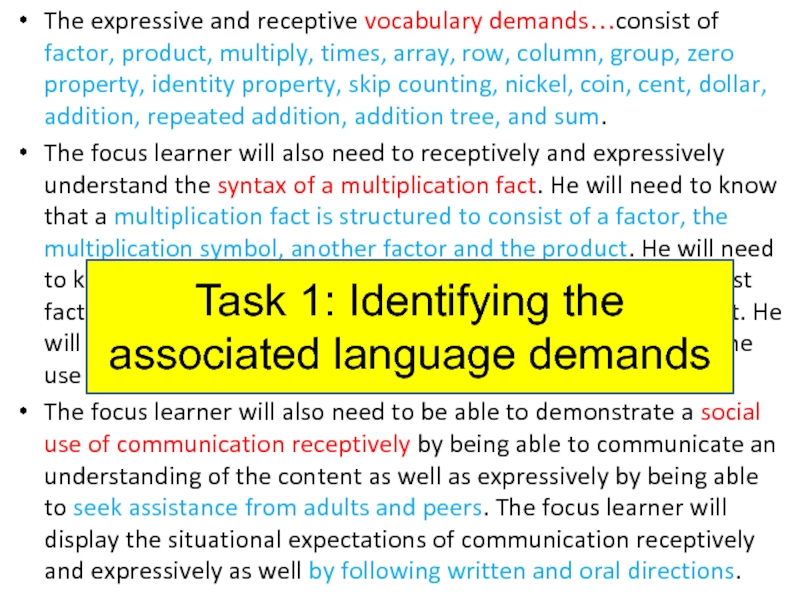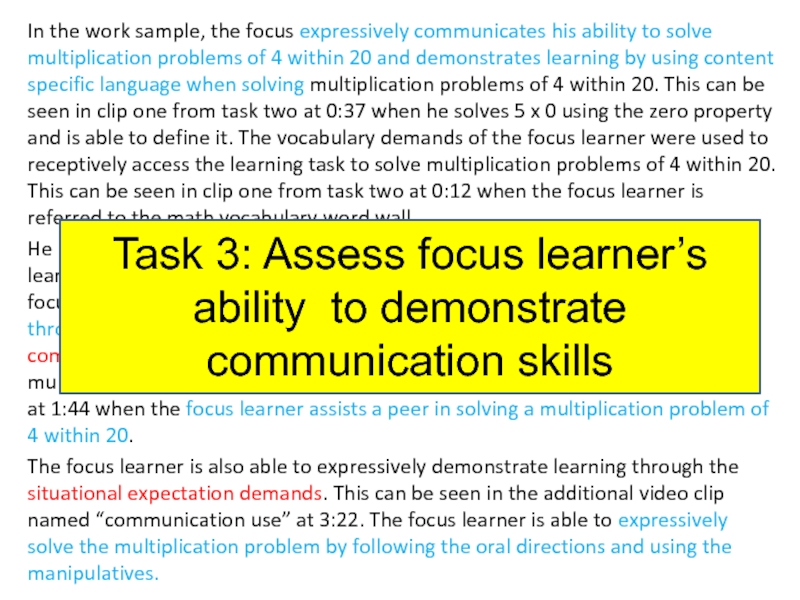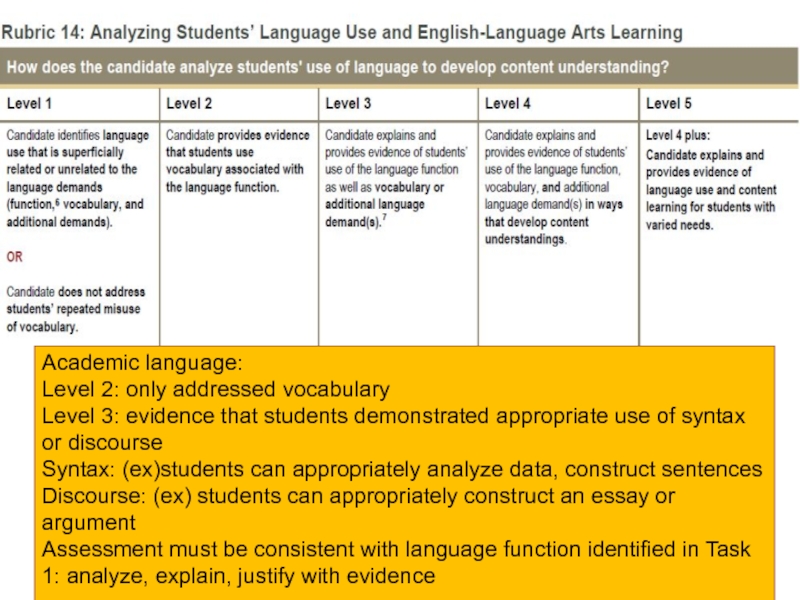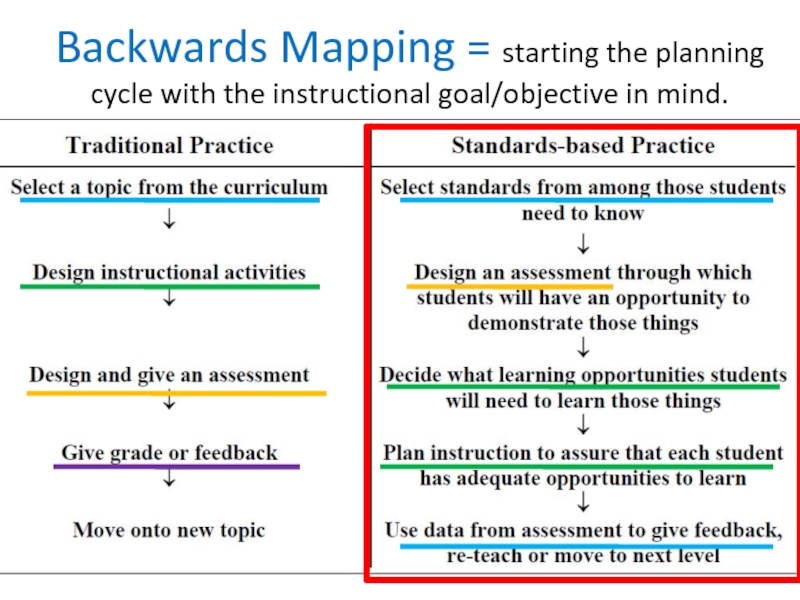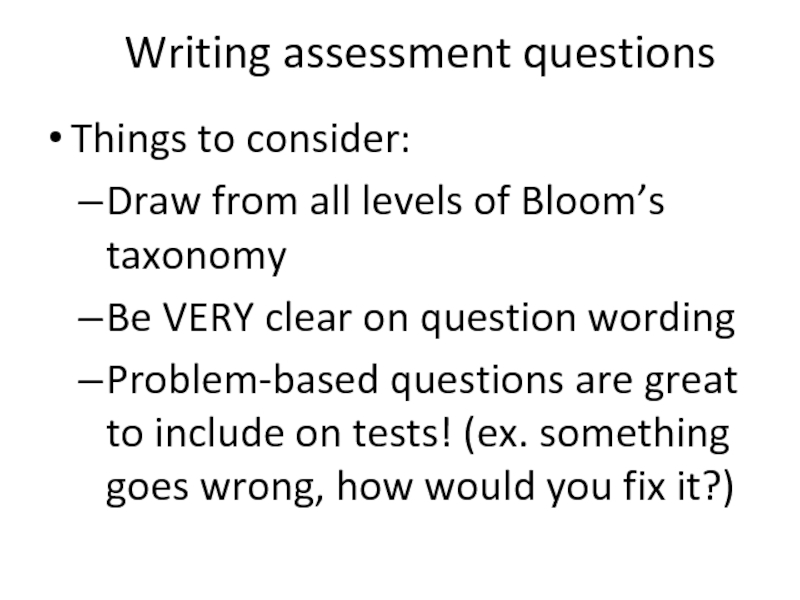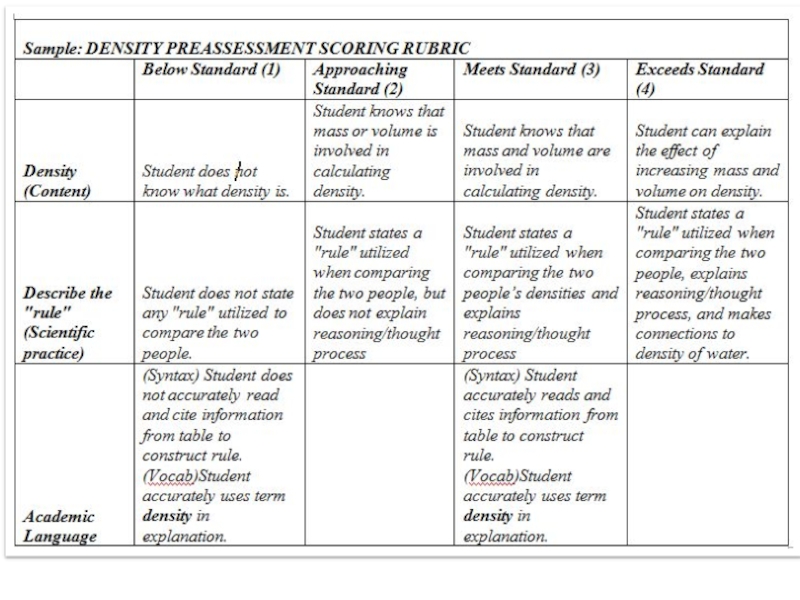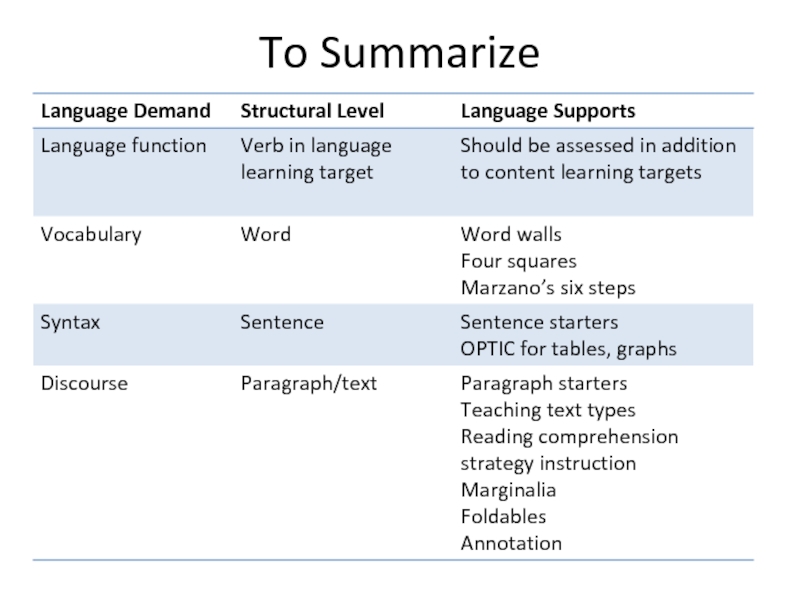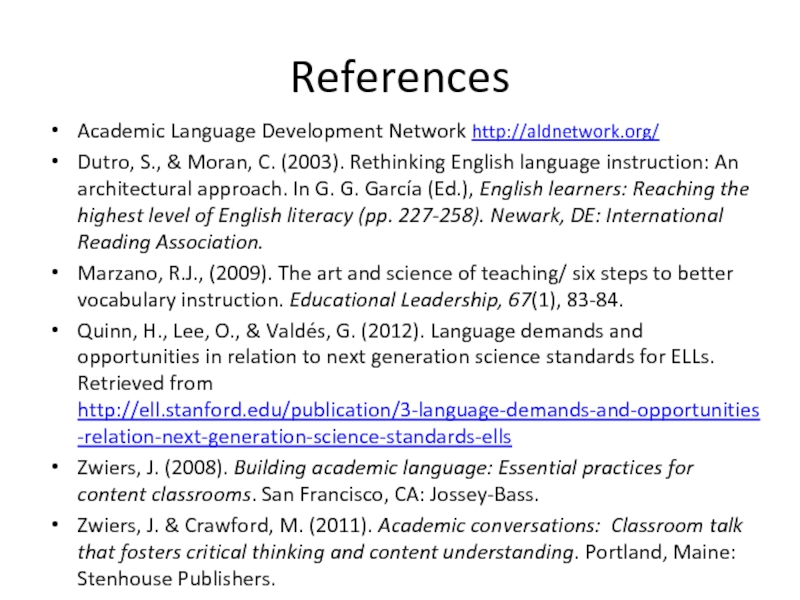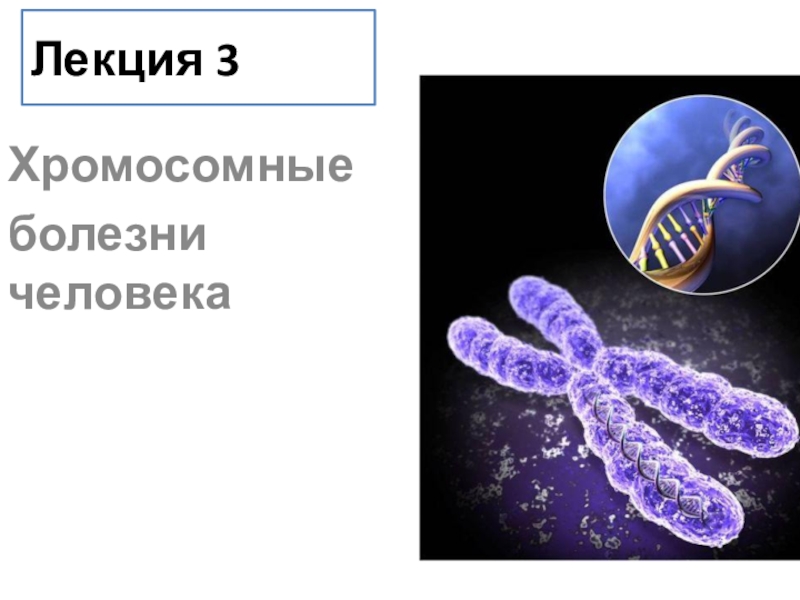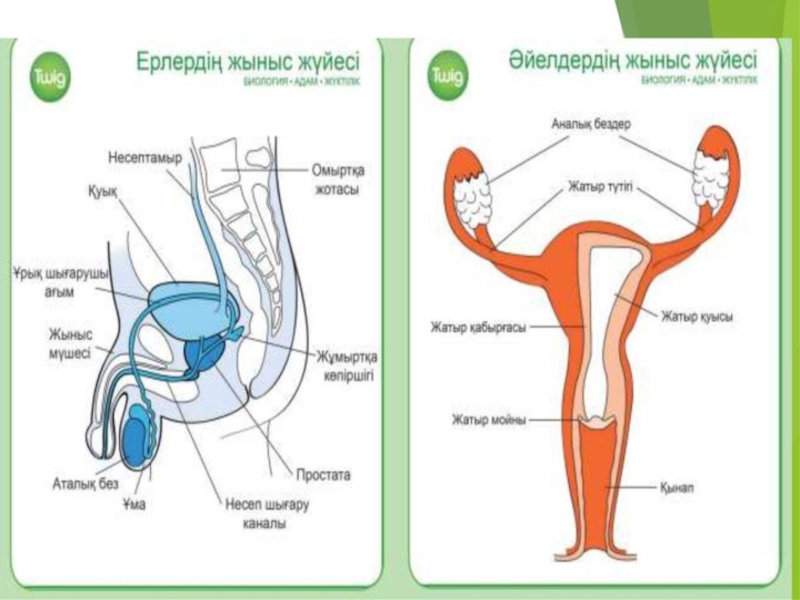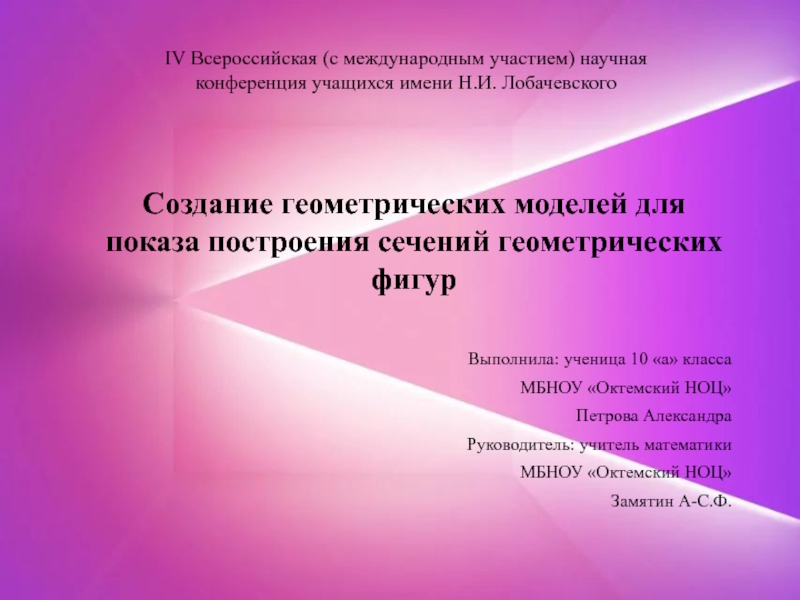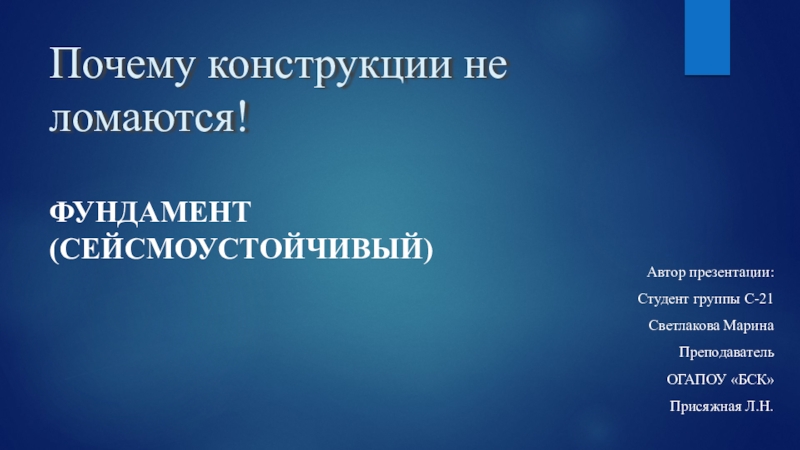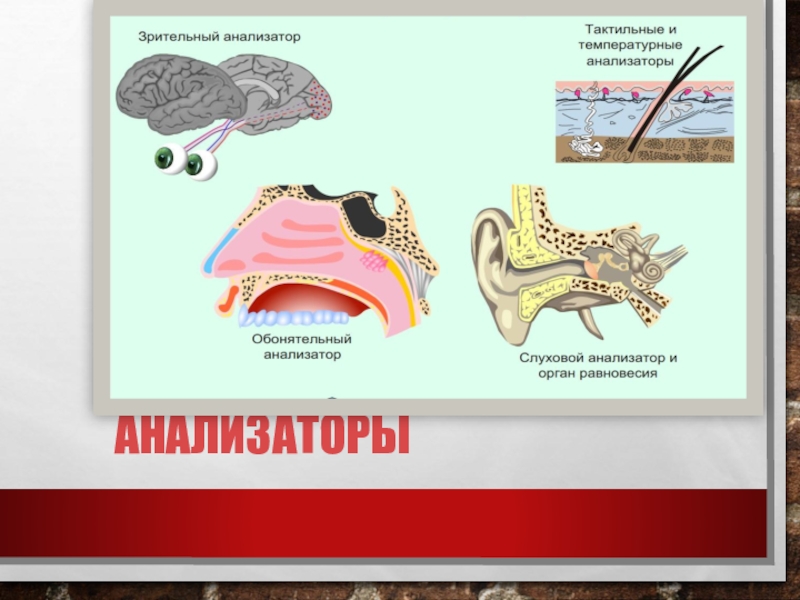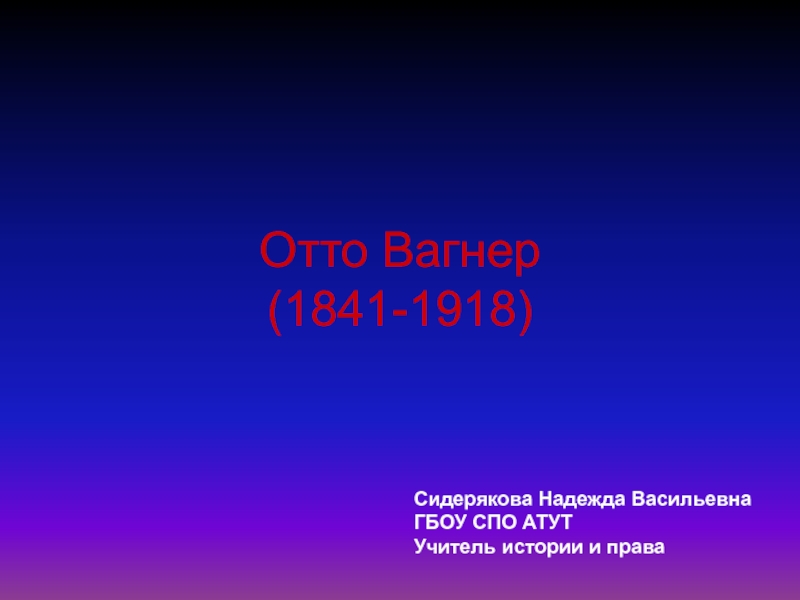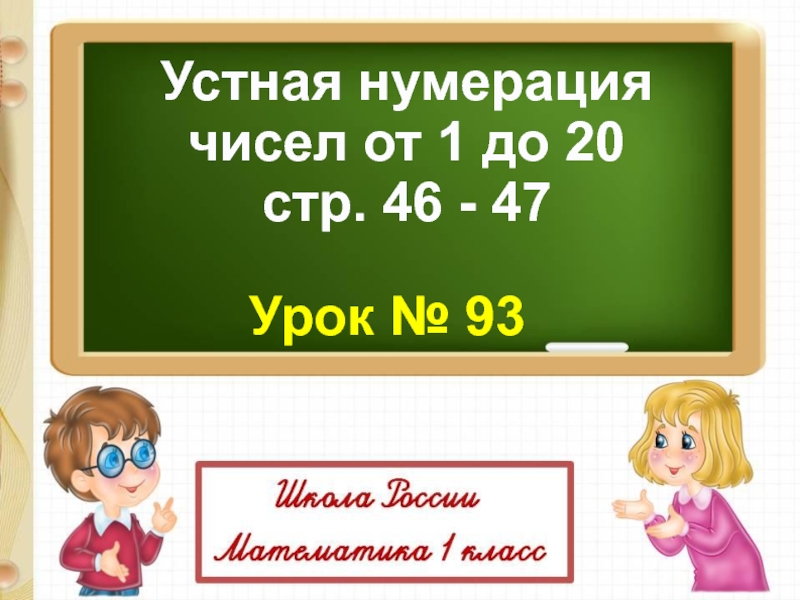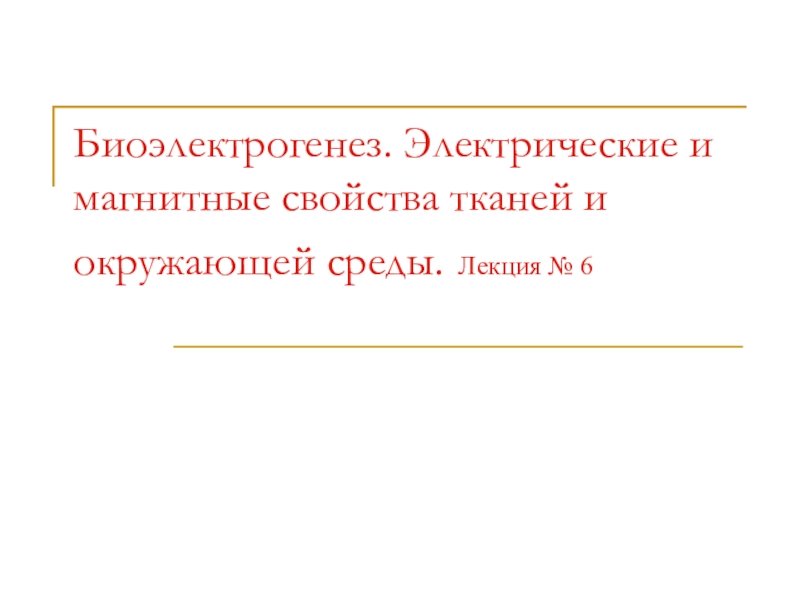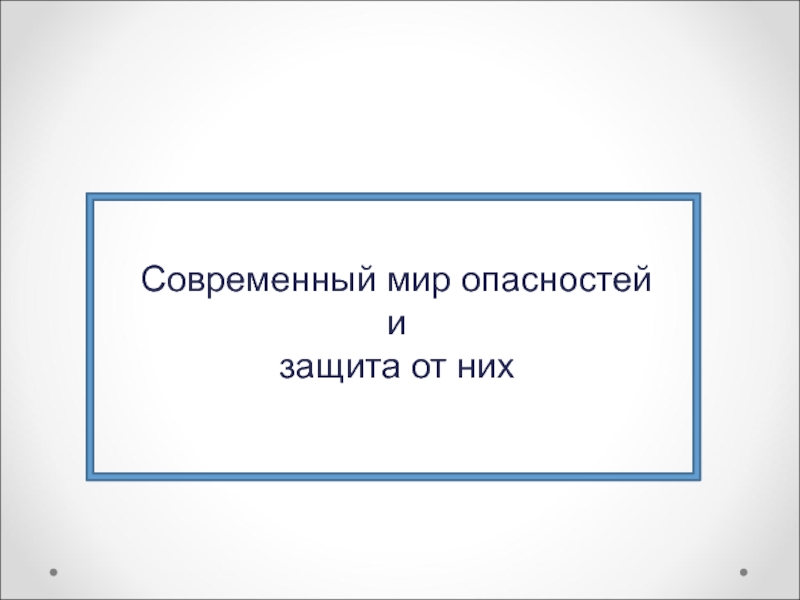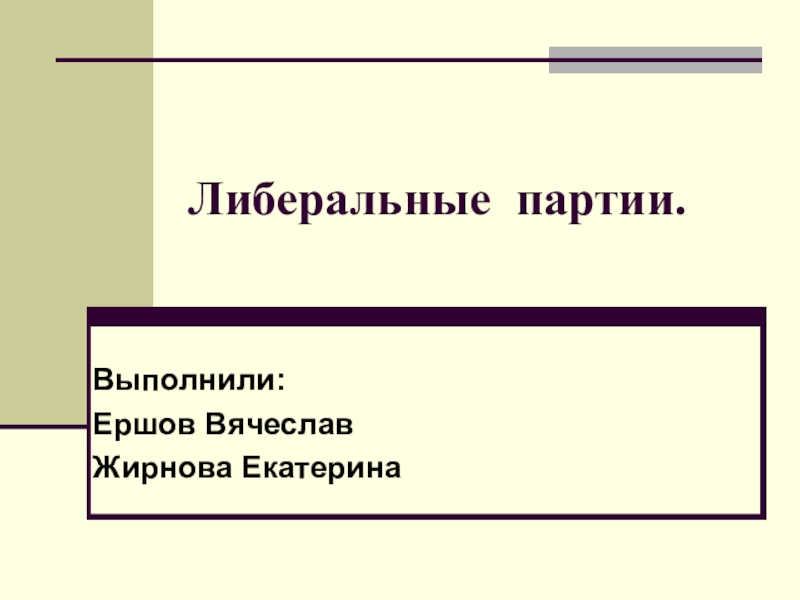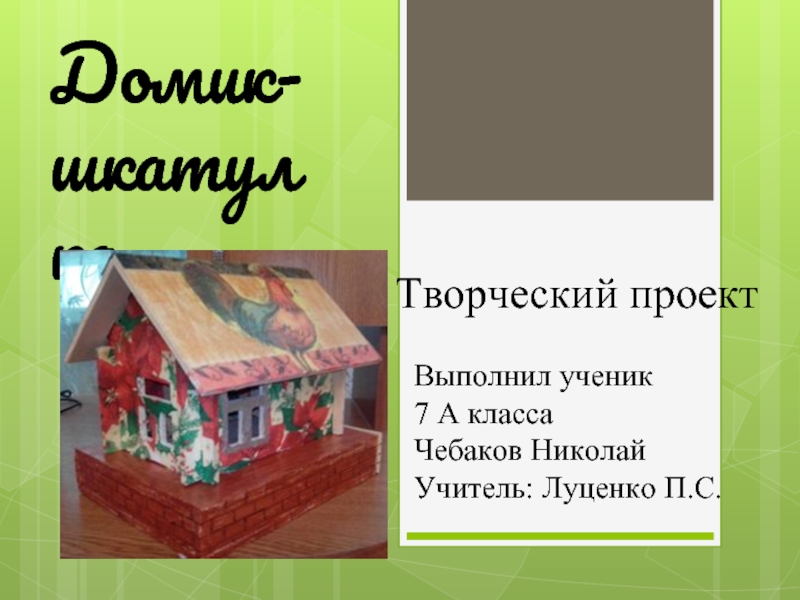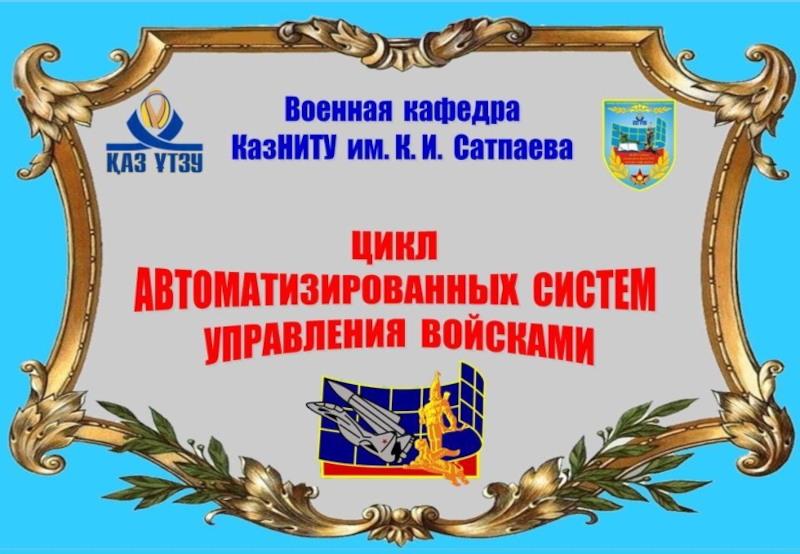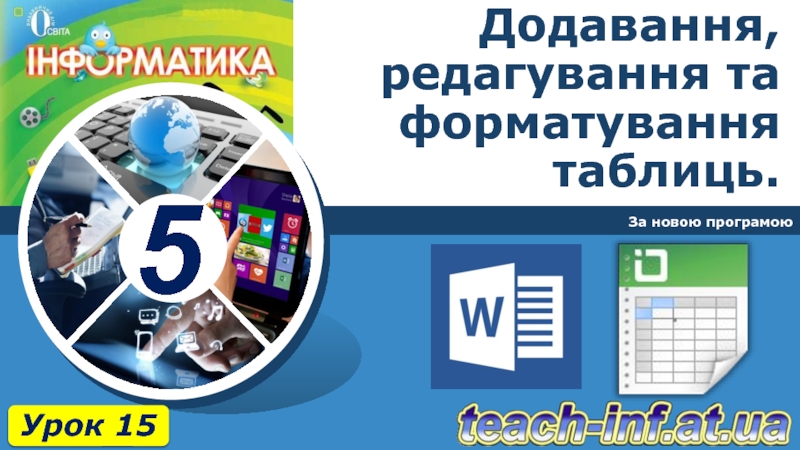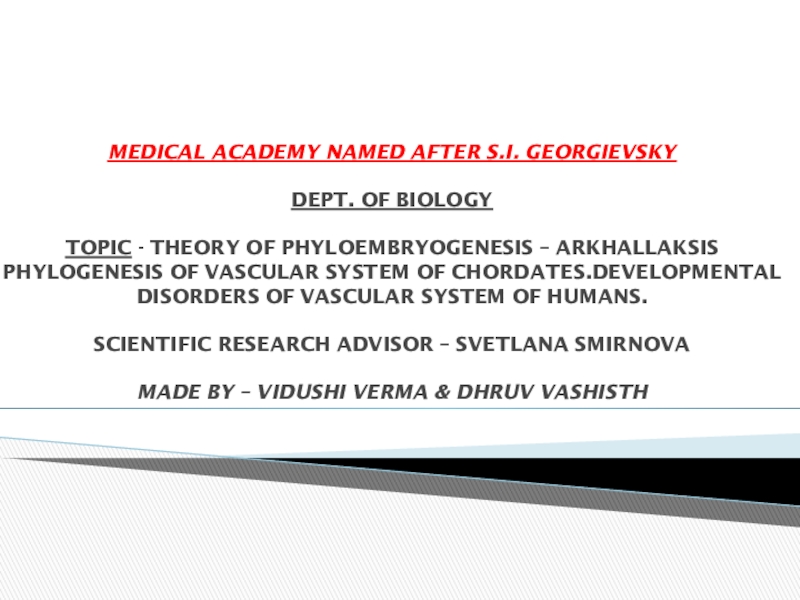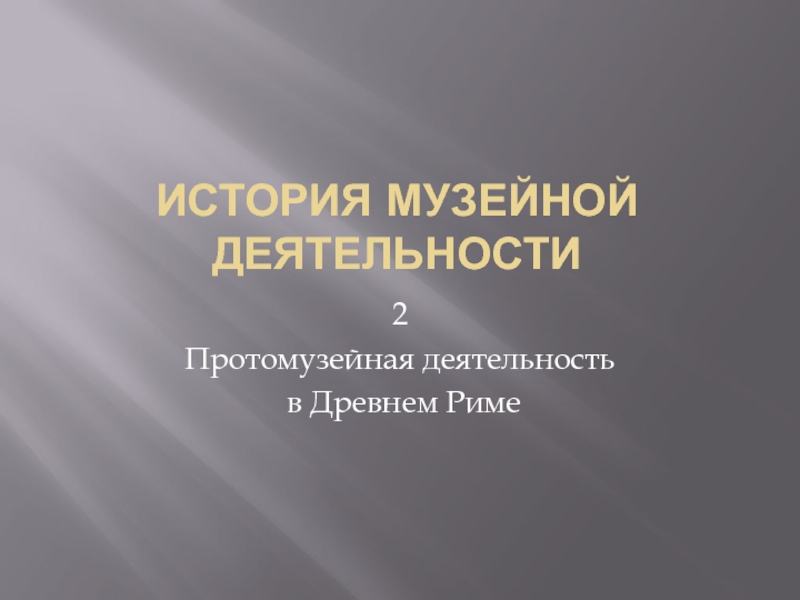Разделы презентаций
- Разное
- Английский язык
- Астрономия
- Алгебра
- Биология
- География
- Геометрия
- Детские презентации
- Информатика
- История
- Литература
- Математика
- Медицина
- Менеджмент
- Музыка
- МХК
- Немецкий язык
- ОБЖ
- Обществознание
- Окружающий мир
- Педагогика
- Русский язык
- Технология
- Физика
- Философия
- Химия
- Шаблоны, картинки для презентаций
- Экология
- Экономика
- Юриспруденция
VORONEZH STATE UNIVERSITY
Содержание
- 1. VORONEZH STATE UNIVERSITY
- 2. AgendaWhat is academic language?How can we help
- 3. A ScenarioMartin: Like, to divide em, you
- 4. Слайд 4
- 5. Слайд 5
- 6. Academic Language Language used in classrooms, found
- 7. Common Core State Standards and Academic Language
- 8. Language Demands
- 9. An AnalogyVocabulary (individual words)Syntax(sentence)Discourse(oral/written text patterns)Vocab, syntax
- 10. Language Function 1. the purpose or reason
- 11. Слайд 11
- 12. Language function must be practiced by students!How
- 13. Receptive vs. Productive Language SkillsEnglish learners tend
- 14. PlanningPrepare lessons with language learning target in
- 15. Sample Language Functions and Associated Language Demands
- 16. VocabularyDefinition:Words and phrases that are used within
- 17. Specialized Academic Vocabulary/General Academic Vocabulary
- 18. Can you find the brick and mortar
- 19. Can you find the brick and mortar
- 20. What happens when only bricks are used for a building?Implication: use both content and general vocabulary
- 21. Word WallsVisual Tool for Building Academic VocabularyContent
- 22. Characteristics of Effective Vocabulary Instruction: Marzano’s
- 23. Scaffold Instruction 1. Total Physical Response to
- 24. SyntaxSet of conventions for organizing symbols, words,
- 25. Syntax Syntax is basically the structure of
- 26. Syntax When we look at how a
- 27. Sentence Stems
- 28. Comparing and ContrastingLanguage Frames:1. One similarity/difference between
- 29. Sentence Stems for Partner/Group Share“The text is
- 30. DiscourseHow people who are members of a
- 31. Text Types - the way that text
- 32. Example of DiscourseScientists and essayists would organize
- 33. Persuasive Essay Thesis, argument, counter argument, rebuttal,
- 34. Reading Comprehension StrategiesPredictQuestionClarifySummarize
- 35. AnnotationThe writer of this piece:provides a
- 36. Special Education1. Identify communication skills (function)receptive skills
- 37. Candidate sample Task 1: Identifying the
- 38. The expressive and receptive vocabulary demands…consist of
- 39. In the work sample, the focus expressively
- 40. Note: Academic Language should be seamlessly embedded
- 41. Academic language:Level 2: only addressed vocabularyLevel 3:
- 42. Backwards Mapping = starting the planning cycle
- 43. Subject-specific assessment criteria
- 44. Designing an assessmentStep 1: Select a set
- 45. Writing assessment questionsThings to consider:Draw from all
- 46. Слайд 46
- 47. Слайд 47
- 48. Additional language demands:Syntax: Annotate text using annotation
- 49. To Summarize
- 50. Zwiers, 2008 “ … if we just
- 51. ReferencesAcademic Language Development Network http://aldnetwork.org/ Dutro, S.,
- 52. Скачать презентанцию
Слайды и текст этой презентации
Слайд 1VORONEZH STATE UNIVERSITY
Academic Language
Understanding the Role of
Academic Language
within Literacy Development and its Implications
Слайд 2Agenda
What is academic language?
How can we help students to build
the academic language that they need to succeed in school/university?
How
can our education programs support candidates in embedding/inserting academic language into university practice?Слайд 3A Scenario
Martin: Like, to divide em, you turn the second
one over and times it by the first one. But
ya gotta see if any numbers fit into the top and bottom to cross em out and get em smaller so you don’t get big numbers at the end. At the end you see if you can make the top and bottom as small as possible.Leslie: In order to divide two fractions, take the reciprocal of the second one and multiply by the first. Before multiplying though, see if any numerators and denominators have common factors that cancel out. For example, if a nine is above and three below, divide by three and you end up with three on top and one below. Multiply the numerators across the top and the denominators across the bottom. See if the answer can be further reduced.
Слайд 6Academic Language
Language used in classrooms, found in textbooks, and
presented on tests that students must master in order to
succeed in any content area.Students need to be equipped to learn new knowledge through reading and listening and to clearly express their knowledge and ideas through discussions and writing.
Believed to be one of the most important factors in the academic success of English Language Learners (ELLs).
Moving students, particularly ELLs, from the less complex Basic Interpersonal Communicative Skills (BICS) to a more complex and abstract Cognitive Academic Language Proficiency (CALP) requires specialized teaching and support.
Слайд 7Common Core State Standards and Academic Language
The Common Core
State Standards require the teaching of Academic Language as well
as subject specific content and address a student’s ability to:reason abstractly
construct viable arguments
critique the reasoning of others
construct explanations
design solutions
engage in argument from evidence
ask questions
define problems
Academic Language is the type of abstract, demanding language that students need in order to be college and career ready and professionally mobile.
Слайд 8
Language Demands
Specific ways that academic language is used as
students participate in learning tasks.
The language demands include:
Language
FunctionsVocabulary
Syntax
Discourse
Слайд 9An Analogy
Vocabulary (individual words)
Syntax
(sentence)
Discourse
(oral/written text patterns)
Vocab, syntax and discourse are
the tools used to accomplish the language function.
Слайд 10Language Function
1. the purpose or reason for using language
in a learning task
2. represented by action verb within the learning outcome *Identify one major language function associated with deep content learning (central focus).Слайд 12Language function must be practiced by students!
How often do you
summarize information? predict outcomes? classify information? (every day, month…)
It is
not enough to define the language function. students need to practice the language function as much as possible.Слайд 13Receptive vs. Productive Language Skills
English learners tend to develop receptive
skills (listening and reading) faster than productive skills (speaking and
writing)The students should practice both receptive and productive language skills in lessons!
We should be primarily concerned with assessing students’ productive language skills every time.
Слайд 14Planning
Prepare lessons with language learning target in mind
Lesson Delivery:
Build/scaffold students’
schema/ background
Use realia and “hands on” materials
Engage students in 90-100%
of the lessonVary techniques to make content concept and vocabulary clear
Model and provide ample opportunities for students to use strategies
Provide frequent opportunities for interaction
Review/Assessment
Provide comprehensive review of key concepts and vocabulary
Conduct informal, quick assessments of comprehension and learning
What is more effective in teaching Acad. Lang?
Слайд 16Vocabulary
Definition:
Words and phrases that are used within disciplines including:
words
and phrases of everyday speech usually learned in early grades;
rarely requires direct instruction (e.g., book, run, animal)general academic vocabulary used across disciplines (e.g., compare, analyze, evaluate)
subject-specific words defined for use in the discipline
Quinn, H., Lee, O., & Valdés, G. (2012). Language demands and opportunities in relation to next generation science standards for ELLs. Retrieved from http://ell.stanford.edu/publication/3-language-demands-and-opportunities-relation-next-generation-science-standards-ells
Слайд 17Specialized Academic Vocabulary/General Academic Vocabulary
(Bricks) (Mortar)
Utility words to hold bricks togetherContent Specific/Technological Words Words across a variety of domains –
democracy, mammal, numerator evidence, consequently, dependent,
nevertheless
(Dutro & Moran, 2003)
Слайд 18Can you find the brick and mortar words?
One season, there
was a shortage of producers in a food web. As
a result, the number of deer and wolves decreased. The reason that both the deer and wolf populations declined is that:A. producers are not as important as consumers in a food web
B. more consumers than producers are needed to support the food web
C. organisms in this food web are interdependent
D. populations tend to stay constant in a food web
(New York State Regents High School Exam: Living Environment Item 3, August 13, 2008)
Слайд 19Can you find the brick and mortar words?
One season, there
was a shortage of producers in a food web. As
a result, the number of deer and wolves decreased. The reason that both the deer and wolf populations declined is that:A. producers are not as important as consumers in a food web
B. more consumers than producers are needed to support the food web
C. organisms in this food web are interdependent
D. populations tend to stay constant in a food web
(New York State Regents High School Exam: Living Environment Item 3, August 13, 2008)
Слайд 20What happens when only bricks are used for a building?
Implication:
use both content and general vocabulary
Слайд 21Word Walls
Visual Tool for Building Academic Vocabulary
Content words (bricks) –
reciprocal, parabola
General Academic words (mortar) – define, explain
Classroom discussion
terms – I believe that … I don’t understand why …, I found that …Terms for writing – In conclusion, The next step is …(Zwiers, 2008)
Content Words General Academic Words Discussion Terms Terms for Writing
Слайд 22Characteristics of Effective Vocabulary Instruction:
Marzano’s Six Steps (2009)
1. The
student searches for a description, explanation, or example of the
new term.2. Students restate the explanation of the new term in their own words.
3. Students create a non linguistic representation of the term. Students can draw or use a picture, show a video, use a graphic organizer, make a web map, demonstrate with a real thing.
4. Students periodically do activities that help them add to their knowledge of vocabulary terms.
5. Periodically students are asked to discuss the terms with one another.
6. Periodically students are involved in games that allow them to play with the terms.
These strategies are particularly important to use with our English Language Learners but all students need opportunities to practice using new vocabulary!
Teaching Channel College Talk: Improving Students’ Vocabulary
Слайд 23Scaffold Instruction
1. Total Physical Response to Language
2. Choral Repetition
3.
Model Use of Language
4. Picture Walk
5. Word Bank
6.
Self-editing of writing7. Study Adjective and adverbial Forms – hardly, scarcely, rarely, next, last, least,
8. Work on words to express Logical Relationships – if, because, therefore, however, unless, almost , always, never
9. Study the academic language in the context of content instruction
10. Study the use of prepositions – above, over, from, to, until, beside, near
Слайд 24Syntax
Set of conventions for organizing symbols, words, and phrases together
into structures
Syntax helps to make the content recognizable to others.
In
reference to sentences, syntax is how a sentence is worded and structured in ways that can create, extend, or effect meaning.Слайд 25Syntax
Syntax is basically the structure of sentences and sentences
must follow certain structural rules to make sense.
Order words make
sense need to (This doesn’t make sense!)
Words need order to make sense. (Now I understand.)
Слайд 26Syntax
When we look at how a sentence is worded
or the syntax of a sentence, we can look at
types of sentences (declarative, interrogative, exclamatory, imperative).Sentence Stems are often tools that are used to help give students the words and the structures needed as they organize their writing.
Слайд 28Comparing and Contrasting
Language Frames:
1. One similarity/difference between _____ and ____
is _____.
2. ____ and _____ are similar because they
both ______.3. Whereas _____ is … _______ is …
4. ______ is … Similarly/In contrast, _____ is …
Language of Agreeing:
1. My idea/explanation is similar to/related to …
2. I agree with (a person) that …
3. My idea builds upon (a person’s) idea …
4. I don’t agree with you because …
(K. Kinsella, 2017)
Слайд 29Sentence Stems for Partner/Group Share
“The text is about …”
“The main
idea is …”
“The most important details are …”
“I learned …”
“My partner pointed out …”“We agreed that …”
“We decided that …”
The students should use specific “sentence stems” to support the use of academic language and to scaffold structured dialogue.
Feldman, K., & Kinsella K. (2015)
Слайд 30Discourse
How people who are members of a discipline talk and
write
How do we create and share knowledge?
What is the structure
of our written and oral language?*Discourse - any time students speak or write. Discipline specific discourse has ways of structuring oral or written language (text structure) to communicate content.
Слайд 31Text Types - the way that text is structured to
communicate content
Expository – intent is to explain something, make an
idea clear, define a term, give a direction – INFORMPersuasive – always targeted toward action, represents power as when you persuade someone to lend you ten dollars.
Descriptive – make the reader aware as vividly as possible as to what the writer has perceived – piece of music, the odor of the basement
Narrative – concerned with action, with events in time and answers the question as to what happened and how it happened
Слайд 32Example of Discourse
Scientists and essayists would organize text and present
supporting information to justify a position with different structures of
discourse patterns. In Science, you frequently add notes to a diagram or a graph.In English, you go deeper into specific meaning, make connections, and identify and explore key literary elements.
Слайд 33Persuasive Essay
Thesis, argument, counter argument, rebuttal, conclusion
If the language
function is to persuade, then the appropriate language structure includes
claims, supporting evidence, and counterarguments.
Слайд 35 Annotation
The writer of this piece:
provides a title to establish
the topic
supplies facts and information about the topic
provides a conclusion
This
piece illustrates the writer’s awareness of beginning-of-sentence capitalization and end-of-sentence punctuation as well as the use of capital letters in proper nouns.Learning Suggestions:
Use of linking words
Organization: successful grouping of like facts (Spain looks like a upside down hat and Spain has a lot of different people.)
Слайд 36Special Education
1. Identify communication skills (function)
receptive skills – listening, reading
(text, pictures, signs)
expressive skills – speaking, writing, demonstrating
representational skills –
symbols, notations, gestures, facial expressionsThe communication skill (function) is basically the purpose for communicating in a learning task in order to deepen understanding of the learning target.
2. Additional communication demands include:
Vocabulary
syntax – sequenced pictures
social skills – waiting your turn
situational expectations – how to speak with an employer as compared with a friend.
Goal is still one of effective communication of academic learning!
Слайд 37Candidate sample
Task 1: Identifying the communication skill
The focus learner’s
communication skill is to solve a multiplication problem of 4
within 20...This means that when the focus learner encounters a multiplication problem with 4 as one of its factors, he will be able to find the product. He will communicate the solution of multiplication problems of 4 within 20 using content specific language such as factor, product, group, zero property, and array.Слайд 38The expressive and receptive vocabulary demands…consist of factor, product, multiply,
times, array, row, column, group, zero property, identity property, skip
counting, nickel, coin, cent, dollar, addition, repeated addition, addition tree, and sum.The focus learner will also need to receptively and expressively understand the syntax of a multiplication fact. He will need to know that a multiplication fact is structured to consist of a factor, the multiplication symbol, another factor and the product. He will need to know that this structure indicates a sequence in which the first factor will be multiplied by the second factor, creating a product. He will also need to know that the multiplication symbol signifies the use of multiplication.
The focus learner will also need to be able to demonstrate a social use of communication receptively by being able to communicate an understanding of the content as well as expressively by being able to seek assistance from adults and peers. The focus learner will display the situational expectations of communication receptively and expressively as well by following written and oral directions.
Task 1: Identifying the associated language demands
Слайд 39In the work sample, the focus expressively communicates his ability
to solve multiplication problems of 4 within 20 and demonstrates
learning by using content specific language when solving multiplication problems of 4 within 20. This can be seen in clip one from task two at 0:37 when he solves 5 x 0 using the zero property and is able to define it. The vocabulary demands of the focus learner were used to receptively access the learning task to solve multiplication problems of 4 within 20. This can be seen in clip one from task two at 0:12 when the focus learner is referred to the math vocabulary word wall.He illustrates his receptive understanding of syntax …expressively demonstrate learning as well, which can be seen in clip one from task two at 5:49 where the focus learner is instructed to express a multiplication fact on the smart board through the independent creation of an array. The focus learner’s social use of communication was used to receptively access the learning task to solve multiplication problems of 4 within 20. This can be seen in clip one from task two at 1:44 when the focus learner assists a peer in solving a multiplication problem of 4 within 20.
The focus learner is also able to expressively demonstrate learning through the situational expectation demands. This can be seen in the additional video clip named “communication use” at 3:22. The focus learner is able to expressively solve the multiplication problem by following the oral directions and using the manipulatives.
Task 3: Assess focus learner’s ability to demonstrate communication skills
Слайд 40Note: Academic Language should be seamlessly embedded within the content
Example:
science unit on simple machines
Day 1: what are simple machines?
Day
2: experiment on inclined planesDay 3: write up conclusion on experiment; students taught how to write a conclusion using evidence from experiment
Day 4: reading on simple machines; students taught structure of expository text
Слайд 41Academic language:
Level 2: only addressed vocabulary
Level 3: evidence that students
demonstrated appropriate use of syntax or discourse
Syntax: (ex)students can appropriately
analyze data, construct sentences Discourse: (ex) students can appropriately construct an essay or argument
Assessment must be consistent with language function identified in Task 1: analyze, explain, justify with evidence
Слайд 42Backwards Mapping = starting the planning cycle with the instructional
goal/objective in mind.
Student work from Observation #1
Слайд 44Designing an assessment
Step 1: Select a set objective(s) from your
lesson
Step 2: Create an assessment aligned to the objectives that
will identify what students know and can do and what their misconceptions are. Be sure to assess for content, process/skill and academic language
Step 3: Create a rubric through which you can score the assessment
Step 4 : Analyze assessments. Plan next steps in instruction.
Слайд 45Writing assessment questions
Things to consider:
Draw from all levels of Bloom’s
taxonomy
Be VERY clear on question wording
Problem-based questions are great to
include on tests! (ex. something goes wrong, how would you fix it?)Слайд 48Additional language demands:
Syntax: Annotate text using annotation symbols to extract
information from a dense text.
Discourse: Scaffolding the analysis of what
we’ve read via use of FourSquare and using that as springboard to develop student ideas.Instructional support prior to and during the learning task, is the use of FourSquares, which organize the information students will be analyzing. As students work to complete the four corners of their FourSquares, they will be able to conceptualize the text and their claims as parts of a whole, making it easier to analyze the information they have organized.
Слайд 50Zwiers, 2008
“ … if we just teach our content, we
drastically shortchange our students. They may end up with a
few more facts and skills but miss out on the cultivation of rich dialog and thinking that will serve them their entire lives. Academic language is not just for academic purposes. Whatever students do in the future, they will need to use their academic language tools for a variety of purposes, such as reading contracts, debating issues, arguing for rights, identifying deception and persuasion, solving complex problems, interpreting religious texts, and communicating their ideas in written and oral formats.”Слайд 51References
Academic Language Development Network http://aldnetwork.org/
Dutro, S., & Moran, C.
(2003). Rethinking English language instruction: An architectural approach. In G.
G. García (Ed.), English learners: Reaching the highest level of English literacy (pp. 227-258). Newark, DE: International Reading Association.Marzano, R.J., (2009). The art and science of teaching/ six steps to better vocabulary instruction. Educational Leadership, 67(1), 83-84.
Quinn, H., Lee, O., & Valdés, G. (2012). Language demands and opportunities in relation to next generation science standards for ELLs. Retrieved from http://ell.stanford.edu/publication/3-language-demands-and-opportunities-relation-next-generation-science-standards-ells
Zwiers, J. (2008). Building academic language: Essential practices for content classrooms. San Francisco, CA: Jossey-Bass.
Zwiers, J. & Crawford, M. (2011). Academic conversations: Classroom talk that fosters critical thinking and content understanding. Portland, Maine: Stenhouse Publishers.
